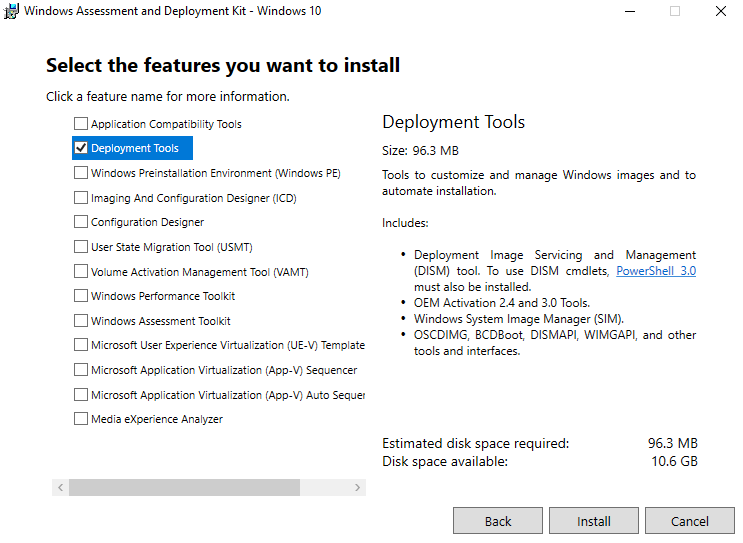Here's how: Open File Explorer. Browse to the folder where you saved the Windows 10 ISO file. Right-click the ISO file, select Open with, and click File Explorer to mount it. (Alternatively, you can also connect the USB flash drive with the installation files.) Open the drive with the Windows 10 installation files. In Windows 10 version 1803 a new installation prompt has been added. As such in pass 7 oobeSystem, you need to add input locale Component which is located in amd64Microsoft-Windows-International-Coreneutral. One other thing that I have changed in the newer version of the Autounattend.xml is that the installer now formats the drive to boot as.
Step 1 – Boot to Windows 10 Audit Mode. Instead, press and hold down the CTRL+SHIFT+F3 keys combination. OS will now reboot to a special customization mode, the Windows 10 Audit Mode. As no user profiles exist yet, Windows will use its built-in administrator account to sign in to Audit Mode. In previous versions of Windows you could leave the computername attribute blank when using an unattend.xml file with sysprep and setup would prompt for a computer name. This isn't the case with Win10. Sysprep and unattend.xml file for windows 10 Hello, how do I create an unattnd file for windows 10 education. Is there a sample or default one somewhere? I have done windows 7 sysprep process before and have been working fine. Can I use the unattended file that I use for windows 7 on windows 10? Also, what is a public token on unattend file? Basic unattend.xml file for Windows 10. The following items are used to allow a script to customize key parameters as needed. 1DomainJoinPW 1AutoLogonAcct 1AutoLogonPW 1OULocation 1ComputerName 1DeploymentScript 1Domain 1FQDN 1LocalAdminPW 1ProductKey. Jul 25, 2019 Windows 10 Installation, Setup. All they need Sysprep. I just need to know where in Unattend.xml file do I need to fill in? Do I need to start with #1 (win PE) or just need to #7 (oobe) and / or #4 (specialize)? I just need to answer what sysprep wants after the reboot, nothing more.
Having seen various questions about unattend.xml installs, and experienced them first hand, I understand some of the unattended Windows install. However, I haven't seen the values to include which automate selecting 'I don't have a product key' (the selection to make when reinstalling Windows 10 on a machine that has already had a Windows 10 install).
Bonus points for the value to include in the unattend.xml file that will allow me to target a specific partition, or 'the free space' available on the disk at the time of install.
Use case: reinstalling Win10 on a future-dual-boot system, where the 'Windows' partition is either left as free space, or previously formatted.
1 Answer
Windows 10 Download
You can skip product key entry by specifying the generic, non-KMS, Win 10 product key that matches your version of Windows (home, pro, enterprise, etc.) in the <specialize> pass.
Depending on your use case, Windows may automatically grab a digital entitlement or BIOS key and activate after OOBE. In other cases, it is necessary to programatically remove the product key and manually grab the BIOS key, or use a valid product key to activate after deployment.
You may, of course, also use a valid product key in your unattend for automatic activation as long as it is a Windows 10 key and not a Win 7 or 8 key.
Win 10 RTM generic keys:

- Generic Windows 10 Home:
TX9XD-98N7V-6WMQ6-BX7FG-H8Q99 - Generic Windows 10 Home Single Language:
7HNRX-D7KGG-3K4RQ-4WPJ4-YTDFH - Generic Windows 10 Pro:
VK7JG-NPHTM-C97JM-9MPGT-3V66T - Generic Windows 10 Enterprise:
NPPR9-FWDCX-D2C8J-H872K-2YT43
Not the answer you're looking for? Browse other questions tagged windows-10partitioninginstallationunattended or ask your own question.

Unattend Xml Windows 10 Prompt For Computer Name
-->The Windows Unattended Setup Reference provides a complete listing of all the settings that you can use to automate the configuration and the deployment of Windows 10.
The Windows Unattended Setup Reference is organized by Windows components and Windows packages, in the same order that the Windows System Image Manager (Windows SIM) tool displays each Windows component and package.
Each Windows component includes settings that can be used to create an unattended-installation answer file. Each setting in a component is listed in its own individual topic. If an element contains a value, valid value types are described and XML examples are given.
Information about how to use Windows SIM is available in the Windows System Image Manager Technical Reference.
Note
All Unattend settings for Windows 10 are also supported in S mode, with the exception of Microsoft-Windows-Shell-Setup-FirstLogonCommands.
In this section

Unattend.xml Windows 10 1809
| Topic | Description |
|---|---|
| Changed answer file settings for Windows 10 for desktop editions, version 1809 | This topic describes Windows 10, version 1809 answer-file settings that have changed since Windows 10 for desktop editions, version 1803. |
| Changed answer file settings for Windows 10 for desktop editions, version 1803 | This topic describes Windows 10, version 1803 answer-file settings that have changed since Windows 10 for desktop editions, version 1709. |
| Changed answer file settings for previous Windows 10 builds | This topic shows the historic list of changes to answer file settings for each build of Windows 10 that was released prior to build 1803. |
| Components | The topics in this section describe all of the unattended settings that can be set in Windows 10 and Windows Server 2016. To determine whether a component applies to the image you’re building, load your image into Windows SIM and search for the component or setting name. For information on how to view components and settings, see Configure Components and Settings in an Answer File |